
Our Conservation and Community Development Projects
Antanetiambo is managed by a motivated local cooperative focused on conservation, education, and sustainable development in the villages surrounding Antanetiambo Nature Reserve. This cooperative, the local Association des Partenaires Ecotouristiques, has collaborated with the Belaoka-Marovato community to complete a range of social and environmental improvement projects (see slide shows below). Most staff and projects are primarily funded by Lemur Conservation Foundation
2016
-
Successful Fish Farm Harvest and Reintroduction
This year Lemur Conservation Foundation organized the annual Paratilapia fish harvest from our model fish pond in Ambodivohitra. This species is locally endemic to this region and has become very rare in local rivers. In total nearly 4000 fish were harvested including over 300 adults which were sold for the high price of 15,000 AR per kilogram (approx. $5 USD). About 2000 fishlings were reintroduced into the large Lokoho River which is known to contain some suitable habitat. -
New English Class
The New English Class has been going well in the Antanetiambo Library. It is taught by one of the leading English teachers in the region, Mr. Dimbysoa, who is actually the brother of Desire RABARY and now lives nearby. The class meets twice a week and has been well attended by people from Belaoka-Marovato. Programs such as this help us to engage the local community near the reserve. We are very lucky that the course is taught by a professional and fluent English teacher.
 Fish Ponds |
 English Class |
2014
-
Habituation has been achieved! The northern bamboo lemur group (Hapalemur occidentalis) is now found each day since the outstanding lemur tracker, Mr. Daniel, has been working with us. The behavior and ecology of this species of bamboo lemur has not yet been studied. It will now be much easier for eco-tourists to observe the group and for researchers to learn more about this virtually unstudied species. It will also be less stressful for the animals.
-
More than 11,000 seedlings in twenty different (primarily native) species have been grown in Antanetiambo's tree nursery. These include endemic hardwoods such as Ebony and Hintsia, fast-growing endemics such as Albizia sp. and Criptocarya sp., super-fast growing Acacia, fruit trees such as Lychee, Banana, and Jack Fruit, and native bamboo. As rainy season (January to April) has just arrived, we have started planting about 1000 trees per week inside some of the newly purchased degraded parcels of Antanetiambo Nature Reserve.
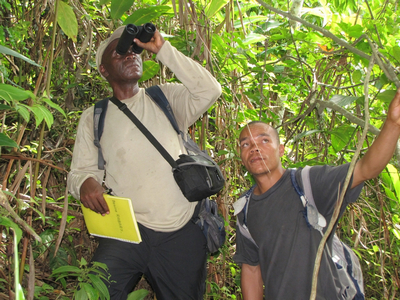 Désiré Rabary and Daniel |
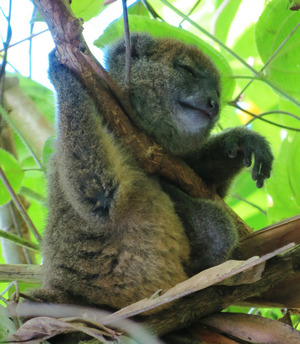 Sleeping Bamboo Lemur - © Dino Raharimanana |
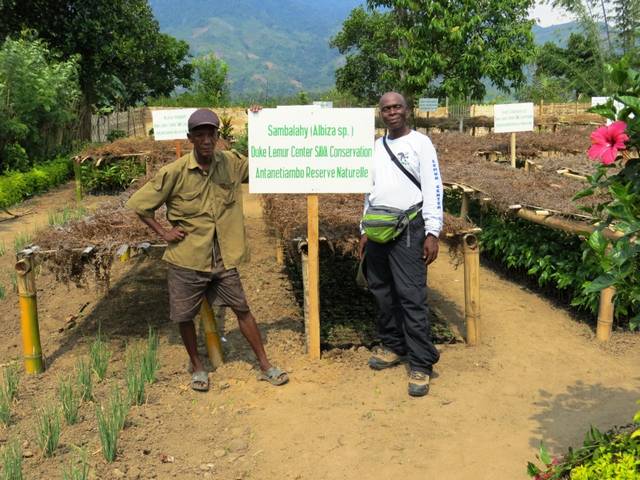 Tree nursery with 11000 seedlings |
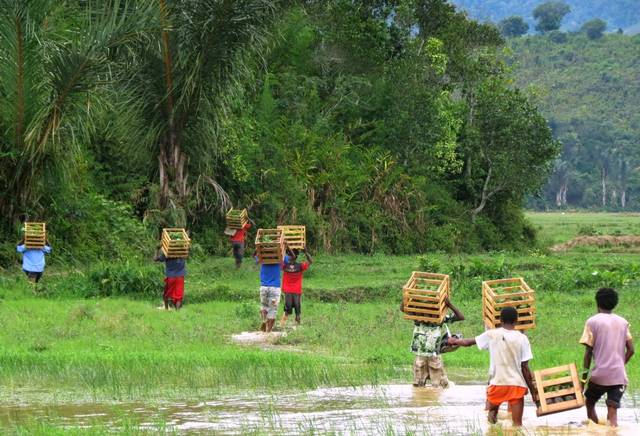 Reforestation in Antanetiambo |
2013
-
Trainers from the ngo CARE led a three day Yam ("Ovy-be") and Tarot ("Sahogo)" growing training for villagers from nearby Belaoka in the Antanetiambo Library. Yams can weigh as much as 25kg, contain more fiber than rice, are easy to grow, and may serve as an important fallback food source during the season of rice shortage. Though tarot does not reach the huge size of yams, it is considered the tastiest of the local tubers, and is the most valuable, selling for a high market price. Both yams and tarot are actually much healthier than manioc/cassava which is widely consumed though it is known to directly contribute to goiter (b/c it blocks iodine uptake) and actually contains high levels of cyanide (particularly the leaves) requiring considerable processing to diminish!
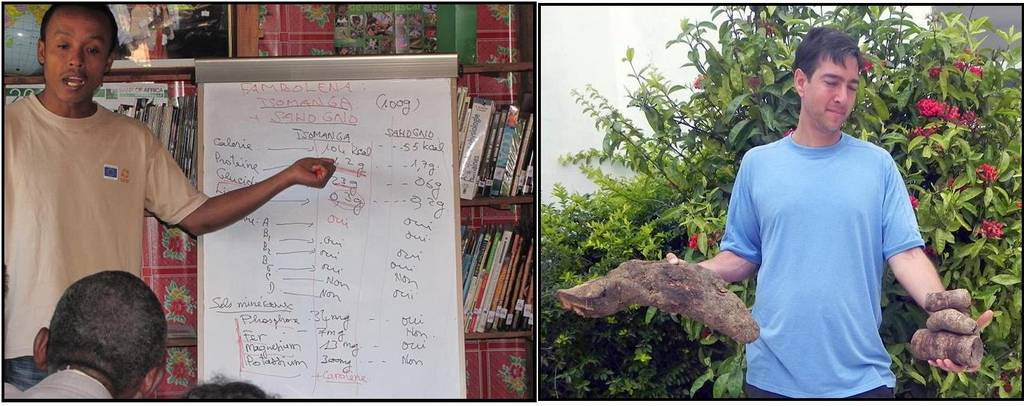
Yam and Tarot training in Antanetiambo
-
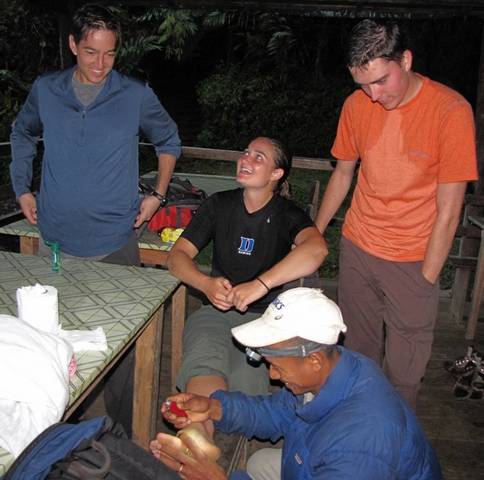
Removing Parasy Parasite eggs at Camp 1 MarojejyDuke University Undergraduates Join the Antanetiambo Team. For 10 weeks from June to August, DukeEngage (http://dukeengage.duke.edu/) students Cameron Tripp and Sophia Staal lived in Andapa at our Duke house in Andapa and worked on GPS Mapping, Bamboo Lemur Tracking, and at the Fish Farm.
Blog: My Malagasy SummerBlog: Cameron's trip/
-
First Fish Harvest Very Successful! As one of our anti-bushmeat hunting programs, we have been breeding a locally endemic fresh water fish called Fony (Paratilapia polleni) at several sites around Marojejy. In September 2012, 400 tiny fishlings were introduced in our model pond in Ambodivohitra. In July 2013, we harvested over 1700 fish including more than 200 large adults which sold for 10,000AR/kg! 600 juveniles were reintroduced into the Matsobe River.
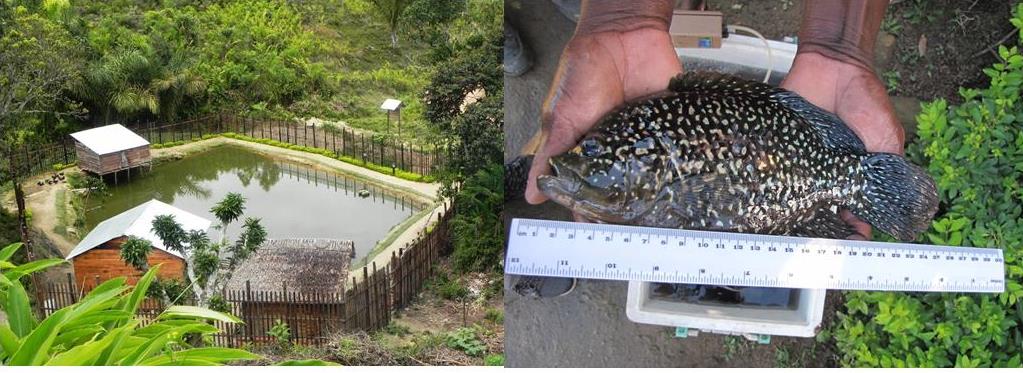
Breeding endemic Paratilapia fishes
-
NEW Toilet and Shower! Antanetiambo now has better toilets and shower than Marojejy which should help boost tourism and research.
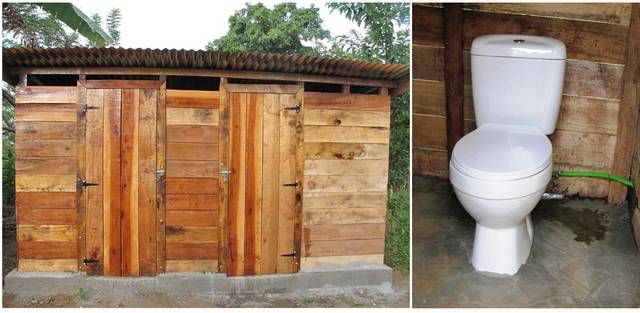
New toilets and shower
-
Tremendous reforestation! Duke Lemur Center planted 4290 trees in Antanetiambo this year and funded US Peace Corps Volunteer Nicholas Reed Krase to plant an additional 2666 trees. A mix of rare endemics (rosewood/ebony), fast growing endemics (hintsia, famelona, tafonana) and fruit trees (litchi, mango, jack fruit, avocado) were planted.
Tree Nursery Created by PCV Nicholas Reed-Krase
-
Antanetiambo Grows in Size! Reserve founder Desiré Rabary has considerably expanded the size of the nature reserve. Since he won the “Seacology Prize” (an international environmental prize which included a cash award of $10,000 USD) in 2010, he has been buying land to increase the size of his reserve. SIMPONA has also funded some of these land parcel purchases. In the past two years he has impressively negotiated several large land purchases, increasing the size of the main reserve (now roughly 35 acres) by about 40% and obtaining several satellite parcels of rainforest along the east side of Marojejy National Park. In the near future, the Duke Lemur Center SAVA Conservation project will assist him in obtaining formal legal land title for his reserve.

Preying Mantis in Antanetiambo
2012
-
Rapid Herpetofauna Survey by researcher Sebastian Wolf. Several parts of the reserve where searched for frogs and reptiles. In total, 13 species are now known from here (some more might be added in future). The frog fauna is rather depauperate due to the lack of ponds and streams. Four species of frogs have been found, the very adaptable Boophis tephraeomystax, Heterixalus andrakata, Ptychadena madagascariensis and a miniaturized narrow-mouth frog, Stumpffia sp. The latter one is among the smallest vertebrates in the world. Interestingly, the snake fauna was quite rich in individuals and species. Together with Rabary’s observations, the snake list comprises now seven species: the colubrids Bibilava lateralis and B. stumpffi, Dromicodryas quadrilineatus, Leioheterodon madagascariensis, Pseudoxyrhopus microps and the two boids Acranthophis madagascariensis and Sanzinia madagascariensis. The chameleon Furcifer pardalis and the green day gecko Phelsuma pusilla are common as well.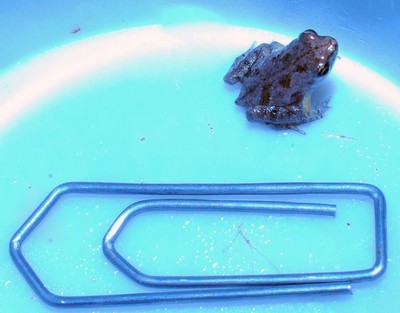
Stumpffia sp. in Antanetiambo -
SRI Plot. Antanetiambo Nature Reserve planted multiple rice plots showing various methods of rice farming. The four plots contain traditional farming methods, line, square model and then SRI. The plots are all next to each other and allow for local villagers to see how well each methods produces. The rice will be mature in the next few months!
- New Library! Thanks to SIMPONA we constructed a local library in Matsobe-Sud. The library contains books in Malagasy, English and French. The library is open seven days a week and is open to the public everyday. SIMPONA also pays the salary of the new librarian, Nadege, who is also the library guardian.
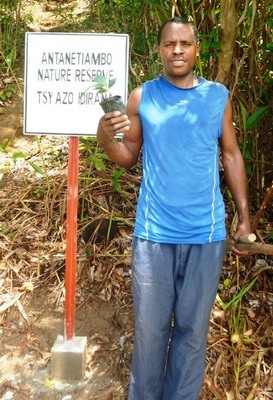 New Antanetiambo Guardian Mr. Ramichel |
- Environmental Education. Funded by SIMPONA, for a little over 2 months, around 290 students from Andapa and Marovato visited Antanetiambo Nature Reserve. The visits consist of a morning in the forest, learning about plants and animals and acquiring new English vocabulary. The afternoon consists of environmental education in both Malagasy and English. The environmental education sessions discuss topics such as biodiversity, tourism, agriculture, and thinking about the future..
- New Reserve Guardian funded by Duke Lemur Center. A new guardian named Ramichel has been hired. He is a local bouncer and a serious and nice man. We expect his full time presence to deter illegal logging of bamboo and various trees in Antanetiambo. Big thanks! to Peace Corps Volunteer Nicholas Reed-Krase for finding Ramichel and supervising his activities.
-
New Paratilapia Fish Farm Pond funded by SIMPONA and Duke Lemur Center. A new large fish farm project has begun which is one of Duke Lemur Center's largest projects in this region, and is a close collaboration with local fish expert Mr. Guy Tam Hyock.
The goal is to encourage Paratiliapia (an endemic, tasty, and easy to breed fish) as an alternative source of protein to help reduce the need for bushmeat hunting in Marojejy which has been on the rise. Raised Paratilapia will also be reintroduced into local rivers where they have become nearly extinct.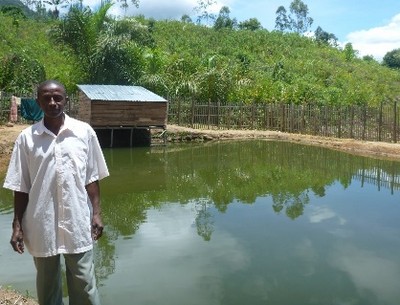
New fish pond guardian, Mr. William.
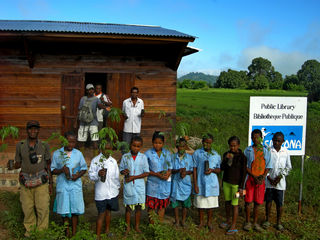 Students visiting the new library and the reserve |
 Students from Marovato visiting the reserve and planting trees |
Désiré Rabary singing a song with visiting students from CEG Andapa |
2011
-
NEW! Two gravity-fed water taps have been installed in the village of Matsobe-Sud, making clean water available to families near Antanetiambo Nature Reserve. Many thanks to our wonderful donors and Madagascar National Parks for their support of this project!
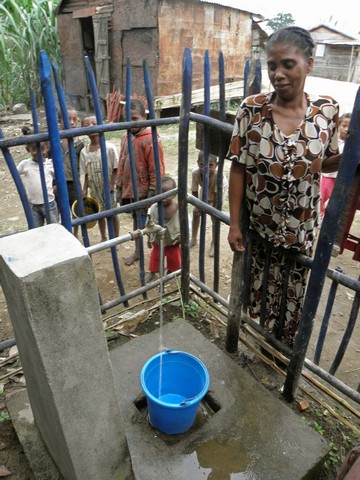 Enjoying the new tap ! photo: Rachel Kramer 2011 |
 Life is easier now. photo; Rachel Kramer 2011 |
Our 2008-2009 projects have been:
> Creating a nature and language learning library for the Rural Commune of Belaoka-Marovato
Antanetiambo staff collaborated with the local community and the middle-school of Belaoka to establish a tri-lingual library with Malagasy, English and French language books, encyclopedias and dictionaries about natural world, improved agriculture, skill development, language learning, as well as story books. The teachers and students of the Collège Elite de Belaoka help us to care for this library. Special thanks to the Norvig family for their gracious donations of books and supplies.
- Booklist (PDF file)
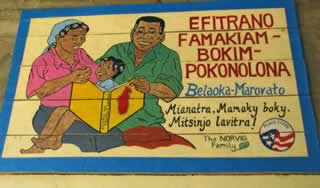 Entrance of the new library photo: Rachel Kramer 2008 |
 Learning Time photo; Rachel Kramer 2008 |
> Coordinating a women’s income-generation project for the village of Ambodigavo
Antanetiambo cooperative members, in partnership with friends in the United States, worked with local tailor Firmin to host a three-week sewing and tailoring workshop for the motivated women’s cooperative of Ambodigavo village. The ladies of Ambodigavo are currently learning to embroider patches for sale at the Reserve.
- Initial Report (PDF file)
- Final Report (PDF file)
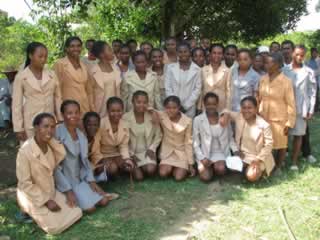 All the members of the women's cooperative photo: Rachel Kramer 2008 |
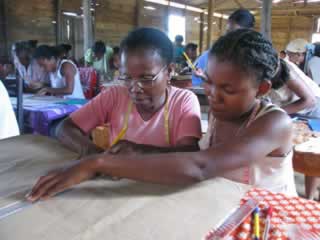 Attentive students photo: Rachel Kramer 2008 |
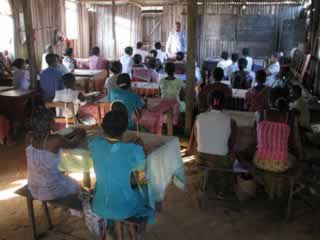 In class photo: Rachel Kramer 2008 |
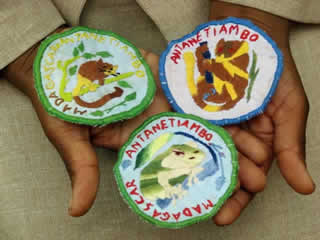 Impressive first results photo: Rachel Kramer 2008 |
> Coordinating an SRI-conservation through improved rice farming project with the women of Antananbaobe village
Antanetiambo has collaborated with the Antananbaobe Village Womens Cooperative and BOSCO, a local agricultural extension agent, to provide training and material support in farming a one-hectare SRI improved rice cultivation demonstration plot. With this plot, we hope to show the community that planting using the more efficient SRI method produces a superior rice yield. Increasing rice production in lowland irrigated areas will ideally reduce reliance on slashing-and-burning forested hillsides for inefficient “an-tanety” rice farming. Encouraging villagers to feed their families while protecting the forest, critical watersheds and preventing topsoil erosion is our goal! Special thanks to Kris Norvig and Monika Patel for their generous support.
- Project report (PDF file)
- Basic explanations (PDF file)
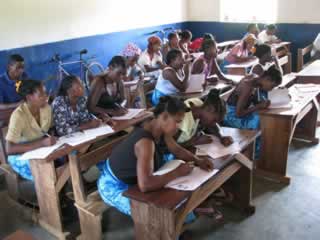 First thing: learning photo: Rachel Kramer 2009 |
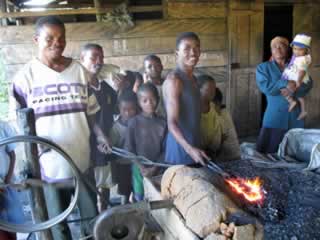 The blacksmith is working hard photo: Rachel Kramer 2009 |
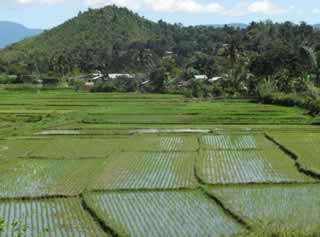 Ricefields planted using the SRI method photo: Rachel Kramer 2009 |
 Singing on the way to work (or just after work?) photo: Rachel Kramer 2009 |
> Developing two gravity-fed clean water taps for the village of Matsobe-Sud
Antanetiambo Reserve is collaborating with Association des Partenaires Ecotouristiques President Louis Toto and local engineer FABIOLA (in collaboration with the neighboring Commune of Marovato) to extend an existing forest-source water line to our host community in Matsobe village. Matsobe’s 1,050 inhabitants currently rely on the nearby river for all water needs, including drinking, bathing, washing and sharing with livestock. This source is at times unsanitary and could pose a threat to public health in the densely populated region of Andapa. Two public gravity-fed water taps are in the process of being installed to provide clean water to the families of Matsobe and travelers on the road to Ambalamanasy. Sincere thanks to friends in the United States for their generous support in funding materials for this project!
 The view from Antanetiambo photo © Eric Mathieu - Marojejy.com 2009 |
 Pastoral scene near Antanetiambo photo © Eric Mathieu - Marojejy.com 2009 |
> Producing local bi-lingual public environmental radio broadcasts
Antanetiambo cooperative member Louis Toto has worked with a local Peace Corps Volunteer to translate and produce a series of environmental radio broadcasts on the ecology and conservation of flagship lemur species to air on the Andapa radio. These broadcasts have played on the Wildlife Conservation Society’s Projet Makira Radio Vary Mangitry timeslot. Through these radio broadcasts we hope to convey environmental messages to a wide listening audience of local students and professionals interested in language learning as well as conservation.
- WCS Radio Broadcasts (PDF File)
- Student Guide (PDF File in Malagasy)
 Transporting rice to town photo © Eric Mathieu - Marojejy.com 2009 |
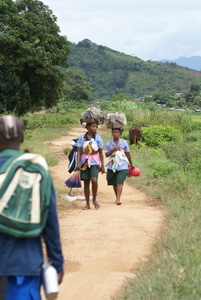 Women walking home from "big" Andapa photo © Eric Mathieu - Marojejy.com 2009 |